-
Paper Information
- Paper Submission
-
Journal Information
- About This Journal
- Editorial Board
- Current Issue
- Archive
- Author Guidelines
- Contact Us
Computer Science and Engineering
p-ISSN: 2163-1484 e-ISSN: 2163-1492
2019; 9(2): 21-30
doi:10.5923/j.computer.20190902.01

LSTM Network for Predicting Medium to Long Term Electricity Usage in Residential Buildings (Rikkos Jos-City, Nigeria)
Abdulsalam Ya’u Gital , Mustapha Lawal Abdulrahman , Jakawa Jimmy Nerat , Emmanuel Nannin Ramson, Okere Chidi Ebere, Badamasi Jafaru
Department of Mathematical Sciences, Abubakar Tafawa Balewa University, Bauchi, Nigeria
Correspondence to: Mustapha Lawal Abdulrahman , Department of Mathematical Sciences, Abubakar Tafawa Balewa University, Bauchi, Nigeria.
| Email: |  |
Copyright © 2019 The Author(s). Published by Scientific & Academic Publishing.
This work is licensed under the Creative Commons Attribution International License (CC BY).
http://creativecommons.org/licenses/by/4.0/

Recently, electricity consumption has significantly increased due to increasing urbanization. It is estimated that buildings consume about 40% of the electricity supply. To minimize the gap between supply and demand, there is need for efficient load forecasting thus, new paradigms have to be implored using automated methods that can dynamically forecast the buildings’ energy consumption. A number of technique and computational approaches have been used recently in order to improve the prediction accuracy. These techniques as presented in the literature would likely have decreased accuracy in application if the weather in the future was significantly different from the weather that was concurrent with the training data. Thus, this research implements an improved model for medium to long term forecasting of electricity usage in residential buildings by using NARX with LSTM while also including weather data as a factor due to its influence and uncertainties to the prediction. The dataset was collected using smart software tools on smart meters and aggregated over 34 buildings in Rikkos Jos- City, Nigeria. The NARX network was built on the top layer of the LSTM neural network to inputs electricity and weather data concurrently to the network. The network was trained using Bayesian regularization back propagation algorithm. The proposed model was evaluated against state-of-the-art prediction techniques use in energy forecasting using RMSE, MAPE and R on Matlab 2018a. The experimental result shows that the proposed model not only curtail future impact of weather uncertainty but also outperforms the existing models in terms of accuracy and model fitting achieving a lower value in terms of RMSE and MAPE.
Keywords: Artificial neural network, Deep recurrent neural network, Multilayered perceptron, Nonlinear autoregressive network
Cite this paper: Abdulsalam Ya’u Gital , Mustapha Lawal Abdulrahman , Jakawa Jimmy Nerat , Emmanuel Nannin Ramson, Okere Chidi Ebere, Badamasi Jafaru , LSTM Network for Predicting Medium to Long Term Electricity Usage in Residential Buildings (Rikkos Jos-City, Nigeria), Computer Science and Engineering, Vol. 9 No. 2, 2019, pp. 21-30. doi: 10.5923/j.computer.20190902.01.
Article Outline
1. Introduction
- The total energy usage in the world is largely covered by building sector consuming about 40% of the electricity usage [1]. Thus, it has become paramount to forecasts building energy usage to reduce high CO2 emissions and for efficient decisions making. Accurate forecast would assist engineers and architect to explore different design options and strategies for building operations. Recently a lot of attention and effort have move towards the design and implementation of smart buildings to balance the demand and supply of electricity effectively [2]. Consumption of electricity is increasing in the last decade as urban areas are constantly increasing respectively [3]. Hence the growing need to bridge the gap between electricity demand and supply, this can be achieved by improving the forecast accuracy thereby enhances planning [4]. Also a minimal improvement of 1% in prediction accuracy will in turn save millions of pounds each year [5]. Thus, economic reasons are the main motivation behind load prediction [6]. Based on this reasons among others, a number of technique and computational methods have been implored recently to improve the prediction accuracy [7].According to Mocanu et al. [8], electricity forecasting can be grouped into either one of these three groups: (i) short term forecast usually ranging from day-week (ii) medium term forecast usually ranging from week-year and (iii) long-term forecast usually ranging from year and above. Physical or data driven bases are the main method or approaches that are implored in the context of electricity prediction [1]. Physical approach mainly depends on the physical principles, building details, and its properties to characterized building behaviors; thus, refers to as the white box models. The performance of this model is subject to fluctuation, because it requires large amount of information thus becoming computationally expensive, particularly if the assumption of this information is not completely fulfill since the model capture building response to influential factors including the outdoors and indoors environment [9]. But a major drawback of this deterministic model is not being able to account for complex consumption behaviors and difficulty in obtaining the input parameters required, thus making poor predictions sometime up to 100% lost in accuracy [9]. Although other options to such models is statistical and ML models [9] and have been successfully applied in this context, such as LR [10], SVM [11] Extreme learning machine [12], stochastic model (CRBM and FCRBM) [8], LSTM [13], RNN [14], Elman neural network [15], Deep Recurrent Neural Network [5] and ensemble technique [16]. Physical models can be hybridized with machine learning models to form hybrid models which have also been proposed in the literature, such as the study in Fu [17]; the Hybrid model is an experiential approach decomposition of DBN and assemble system. In general, hybrid models have proof to achieve high accuracy particularly short-term forecast an hour [18] to a week [19]. But there are few limited work pertaining medium to long term prediction with previous work showing errors in excess of 40-50% as regard to medium to long term forecasting [13].Deep neural networks [5] could greatly improve on the general performance to existing related predictions models by applying multiple layers of abstraction which permit them to model more complex functions [20]. Neural network [21] is popularly applied in electricity load forecasting [22]. The approach tries to learn or model both the input and output nonlinear relationship. Recently, deep learning neural networks [23] have been rapidly develop and have shown to attained higher improvement in prediction as compare to their counterparts’ traditional shallow neural networks. This improvement was achieved due to three reasons which include: a better learning algorithm with multiple hidden layers and the initialization approach of the parameters has greatly contributed towards the success of deep learning approach [24]. Deep recurrent neural network accommodates temporal dependencies of both short and long term as shown by [25]. DRNN address the short comings of long term forecasting observed in previous literature [5]. Despite being a very strong modeler, RNN comes with a shortcoming of training difficulties which was overcome, thereby allowing their smooth application to difficult sequence complications [15]. A number of technique and computational approaches have been implored recently in order to improve the prediction accuracy. These techniques as presented by Rahman et al. [5] would likely have decreased accuracy in application if the weather in the future was significantly different from the weather that was concurrent with the training data. Similarly, there are few limited work pertaining medium to long term prediction with previous work showing errors in excess of 40-50% as regard to medium to long term forecasting [13].This paper is aimed at designing and implementing a model that predict electricity consumption in residential buildings by enhancing the prediction reliability using NARX with LSTM network while including whether information as an external factor to the prediction and evaluate the results against the state of the art. The key contribution of this study is implementing the NARX-LSTM base Network that addresses the high error associated to medium and long term forecast by curtailing future impact of weather to the prediction results, thus enhancing the accuracy and reliability of the proposed model against state-of-the-art prediction techniques use in energy forecasting. The result from this model will greatly assist Jos electricity distribution center in planning and adjusting electricity demand and supply respectively, based on the authors knowledge, no research work of this nature has been carried out in Jos electricity distribution center. Thus, this research hugely contributes to the community. The rest of this paper is divided into sub-sections. Section ii details the theoretical background of Deep Learning methods including ANN, DRNN, NARX and the MLP. Section iii presents the formulation and description of the proposed NARX-LSTM model and the scheme for data normalization and further describes the evaluation setup, Section iv analyzed the simulation results and section v concludes by summarizing the key results, while section vi identified the limitations and confers paths for future research.
2. Literature Review and Theoretical Framework
- This section presents the theoretical background and historical reviews of deep learning computational technique so as to explore the fundamentals of this research work and also identify the recent state of art prediction techniques use in energy forecasting.
2.1. Artificial Neural Network
- ANN is an intelligence computing approach that is made up of neurons which is stirred by the biological neurons. The input and output relationship are complex and is model by activating each neuron from the input node and sends the response to the output node. the traditional ANN is consisting of three main layers (input, hidden and output layers), these layers are interconnected. Each of these layers is comprise of multiple neurons with an activation function with no any systematic framework for selecting the numbers of hidden layers. Although three categories of parameters are implored to define ANN, this includes the connection style, learning procedure and activation [26]. ANN has been applied in different areas because of their intelligence performance such as speech recognition, robotic control, image processing, data mining, and energy forecasting [4]. Trial and error are the most widely method of determining the number of hidden layers for the network training. The error in the network weight is minimized during the training phase, when one of the following occur the training is terminated i.e the gradient performance is below a threshold or the required value is met for the error that is minimized [27]. Despite the computational power of ANN, it comes with a number of draw backs such as model over fitting, random weight optimization sensitivity and probability of local optima convergence. [28].
2.2. Deep Recurrent Neural Network (GRU and LSTM)
- A recurrent neural network can be extended to a deep recurrent neural network via different ways as shown by Pascanu et al. [29]. The concept of depth in RNN was initially argued, but base on the architecture of RNN, three areas can be make deeper in other to construct a DRNN, this includes; hidden to hidden function, hidden to hidden transition and hidden to output function [29]. There are different variants of DRNN but we will focus on the popular DRNN use in the context of electricity forecasting including LSTM and GRU. The idea of RNNS with gated units was first introduced by Hochreiter and schmidhuber. [30]. LSTM is suitable for modeling long range dependencies, LSTM's architecture has memory blocks Compared to RNN which has hidden units [31]. The memory cells which are modulated by nonlinear sigmoidal gates are contained in a memory block, which are multiplicatively applied. Memory of the same gates share cells so as to reduce the parameters. The model stores the values at the gates (when the gates evaluate to 1) or remove them (when the gates evaluate to 0) as determine by the gates. With this, long-range temporal context can be exploit by the network [32]. In order to solve the problem of vanishing gradient during forward and backward phases, the vanishing gradient are alleviated to allow the network preserve it memory over some time steps. The studies in Chung et al. [33], found both GRU and LSTM to be comparable. Training speed of GRU is faster due to the less parameter as compared to other RNNs such as vanilla RNN [34].An LSTM layer is a Recurrent Neural Network (RNN) layer that enables support for time series and sequence data in a network. The layer performs additive interactions, which can help improve gradient flow over long sequences during training. The LSTM Layer Architecture use in this work is depicted in fig 1. The diagram demonstrates the flow of a time series X with D features of length S through an LSTM layer. Where h represents the output (hidden state) and c represents the cell state. The first LSTM unit takes the initial network state and time step of the series X1, and then calculates the first output h1 and the restructured cell state c1.
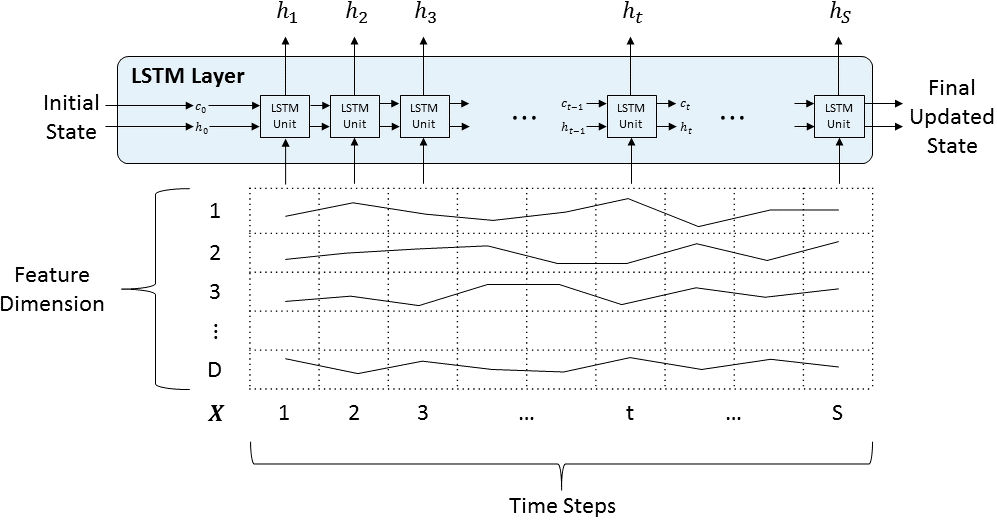 | Figure 1. Architecture of LSTM layer Hochreiter and schmidhuber [30] |
 | (1) |
 | (2) |
2.3. Nonlinear Autoregressive Neural Network (NARX)
- The NARX network is a recurrent dynamic network, with feedback connections enclosing several layers of the network making it suitable for time series forecasting. Time series are a sequence of data, numerical values or observations usually recorded at constant time intervals [35]. It is measured normally every second, minute, hour, day and week or in some cases year. A time series connecting to the variable Z over the time set T is denoted by
 | (3) |
 | (4) |
2.4. Multilayered Perceptron
- Multilayered perceptron’s (MLPs) are special form of feed-forward networks also known as universal approximates. MLPs are the most commonly used neural network architectures due to its simplicity [38]. A feed forward network (MLP) has a layered structure, where each layer is consisting of units that receive their input from units from a directly connected layer below and transmit their output to units in a layer directly above the unit. There exist multiple units in each layer and units of the neighboring layers are fully connected to each other, but no connections in the same layer. For a two-layer neural network, this is also known as multi-layer perceptron.
2.5. Convolutional Neural Network
- LeCun firstly proposed Convolution neural networks (CNNs) for image processing, where two main properties are featured i.e. spatially spatial pooling and shared weights. CNNs where widely applied in various computer application successfully including sequential data, processing of natural language, speech recognition and image classification. Convolutional Neural Networks mainly focus in learning features that are abstract; this is accomplished via stacking and alternating pooling layers and convolution layers respectively. this convolutional kernels i.e. convolution layers in CNN convolve raw input data with numerous local filters hence yield transform local feature with the succeeding pooling layers’ excerpt features and a static-length of the raw input information in stages of numerous rules such as average and max [39].The review understood in this section of the research permits the authors to offer the theoretical foundation essential for the improvement of energy forecasting model, which is presented in the subsequent part of this work.
2.6. Related Work
- There are three categories and method applied in the prediction of energy usage in building, these include statistical method (black box models), engineering methods (white box models) and hybrid methods (grey box model) [40]. both machine learning and statistical model been employed in the previous works as discuss in the literature. For example, Robinson et al. [41] proposes a machine learning approach using natural data from CBECS to forecast both electricity, fuel, and natural gas consumption of commercial building with the aid of the building features that are accessible, similarly Deng, Fannon, and Eckelman [10] test various predictions models for HVAC and energy usage, an improved accuracy was demonstrated by SVM. Also in the work of Kaur and sachin [42], auto regressive moving average ARIMA was use to forecast electricity consumption. Previously in the context of building energy consumption modeling, machine learning models performs better than linear models for example Tso and Yau [43] test linear regression models decision tree and neural network for electricity consumption modeling at building level in Hong Kong. Similarly, Dehalwar et al. [44] use ANN and bagged regression tree for load prediction using data from the metrological agencies, in both cases, neural network performs better. One of the common limitations among statistical, engineering and hybrid models is the availability of vital data [41].There have been limited number of work with regard to medium and long term forecasting either sub-hourly or hourly-intervals with long term prediction being more difficult and complex task to achieve, a relative error often in excess of 40-50% is associated with medium to long term forecasting [8]. Potential improvement on prediction accuracy of the aforementioned machine learning can be obtained using deep neural network where modeling of more complex functioning is allowed by the use of several layers of abstraction (24). These approaches are applied recently in the context of energy prediction for example [17] employ deep learning approach for the determination of cooling load prediction which outperforms SVM and BPNN in terms of accuracy and stability. Similarly, Cheng fan et al. [45] Propose a deep learning for building profile load predictions, an enhance performance was obtaining especially when the deep neural network is use in an unsupervised manner. It was also shown in the studies of [8] where the forecasting accuracy was greatly improved by the integration of DBN into a reinforcement algorithm that can target features of the buildings.The nature of electricity usage behavior is transient, long term dependencies can shape the consumption pattern, one family of algorithm in which the dependencies between consecutive times steps is being accommodate is the recurrent neural network and has been implored in the context of energy forecasting [5]. Recurrent neural networks are known to improve time series prediction errors as shown by (Abdul et al 2018). (Ruiz et al 2017) [46], propose an ENN and optimize the weight with GA, an improved result was obtained compare to previous studies. Similarly, [14] proposed a new recurrent ANN model base on multiplicative neuron model and it was observed that the model produce the most forecast accuracy compared to other forecasting method. However, despite the improvement in the results obtain by modeling time series problems using recurrent neural network, it still suffers from the problem of vanishing gradient as described by hochrieter and Schmidhuber [30] because RNN do not account for long term dependencies. One of the possible solutions to the vanishing gradient as suggested by hochrieter and schmidhuber is RNNS with long short term memories. [18] use a long short term memory base network algorithm for the forecasting of electricity and compared it to BPNN, MLFFNN where LSTM demonstrate higher accuracy as compare to the aforementioned competitive Algorithm [5] develop two deep recurrent neural networks by Stacking LSTM on top of the model using encoder – decoder design for forecasting of electricity consumption in residential and commercial buildings. The two deep RNN performed better than the MLP.
3. Methodology
3.1. Data Collection and Model Input
- To train the model for forecasting, the developed NARX-LSTM network relies heavily on input vectors. Choosing an input vector comprising of external factor produces a better, robust and reliable performance. The proposed model was tested and evaluated on electricity consumption data obtained from the private residentials buildings in Rikkos, Jos City using Smart Software Tools from residential smart meters. The area is located at 9°55’N 8°54’E and mostly covered by residentials buildings of extended families. The dataset that was obtained contains electricity data for 34 buildings for the period 1st January, 2014 to 31st December, 2016. The overall hourly electricity consumption data in residential Buildings can be obtained from Jos Electricity Distribution Centre JED. The features of the dataset consisted of a combination of weather, date and electric load consumption related variables respectively. This electricity consumption data in residential buildings is then aggregated over an increasing number of residential buildings, up to a maximum of thirty-four buildings. For a given number of buildings over which the residential building energy consumption was aggregated, the residential buildings were selected in ascending order of the building ID. The weather data that was used for concurrent training and prediction by the model which was obtained from NCRS-Jos.
3.2. Model System Development
- To implement the model, the proposed framework is described below so that the architecture must be able to process the data with a high throughput and accuracy. The architecture of the proposed framework is shown in Fig. 2.
 | Figure 2. Proposed Frameworks |
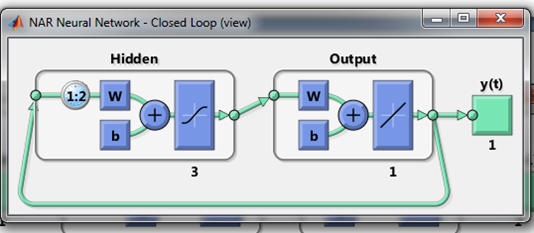 | Figure 3. NAR Neural Network Closed Loop View |
3.3. Choice of Metrics
- For developing forecasting model, the real data is vital. Performance measures allow the evaluation of the accuracy of various forecasting techniques useful to a particular time series. To evaluate the forecast errors, it is necessary to analyzed the performance. Testing the Neural Network is a vital step in the design process. In this experiment, to evaluate the network performance, the Statistical estimating metric presented below is used to ascertain the best performing model. They include: Root Mean Square Error (RMSE), Mean Square Error (MSE), Mean Average Percentage Error (MAPE) and the correlation Error (R).The Root mean squared error metrics used to evaluate the performance of the models is computed as:
 | (5) |
3.4. Evaluation Setup
- The dataset used to train the proposed model contains data for 34 buildings for the period 1st January, 2014 to 31st December, 2016. To evaluate the performance of the models in this study, the data at 30-minute intervals was partitioned into training, testing and a validation set. The features of the dataset consisted of weather, date and electric load consumption related variables respectively. The dataset is Partition into training, test and validation. The first 70% is for training, 15% for test and last 15% for validate respectively. During the experiment, after importing the data, the input and target data where equated and assigned variables and subsequently transpose from columns to rows. The concurrent vectors are converted to sequential vectors. In order to create the NARX network, the delay of the feedback is set to 1:2; with 3 hidden Layer Size, 2 network Input delay and The Training algorithm is set to Bayesian regularization Back Propagation Algorithm. the data was normalized to scaling [-1 to 1] for the experiment. The NARX network predicts y(t+1) at the same time it is given y(t+1).The LSTM network in this experiment learns to predict the value of the next time step. For a better fit and to prevent the training from diverging, we standardize the training data to have zero mean and unit variance. In order to configure the LSTM regression network, we specify the LSTM layer to have 200 hidden units. We set the Input Size to be 1 and number of Responses and Hidden Units to 1 and 300 respectively. The LSTM used in this experiment, is comprised of four layers including sequence Input Layer, LSTM Layer, fully Connected Layer and a regression Layer. For options of the training, we set the solver to 'adam' and train for 500 epochs. To prevent the gradients from exploding, the gradient threshold set to 1 and Specify the initial learn rate 0.005, and drop the learn rate after 125 epochs by multiplying by a factor of 0.2. The training progress plot reports the root-mean-square error (RMSE) and compared the forecasted values with the test data.
4. Results and Discussion
- The accuracy of the estimated forecasts of the proposed model was compared with the other models to determine which model gives a more accurate forecast through the use of RMSE, MSE, MAPE Regression or correlation error (R). We will now present the result for the forecasting using all the different algorithms by the performance standard achieved by each of the model and discuss the findings. The main purpose of the graphs obtained from the model is not to be analysed directly, but rather portrays to the reader a synopsis of the way the trend continues. In order to validate the proposed network, the error autocorrelation is used. auto-correlation analysis provides the basis for immediate future predictions. Fig. 4 display the error autocorrelation function. The figure shows how the prediction errors are related in time. Ideally, for perfect prediction model, there should be only one nonzero value of the autocorrelation function. These nonzero values should occur at zero lag; this is also called mean square error. Such an autocorrelation function would imply complete un-correlation of predicted errors with each other. Base on Fig 4, the correlations, excluding the zero lag, fall almost around the 95% confidence limits within zero, thus the model appears to be suitable. If there were significant correlation in the prediction errors, then it’s possible to improve and enhance the prediction accuracy maybe by changing the neural network structure or increasing the number of delays in the network.
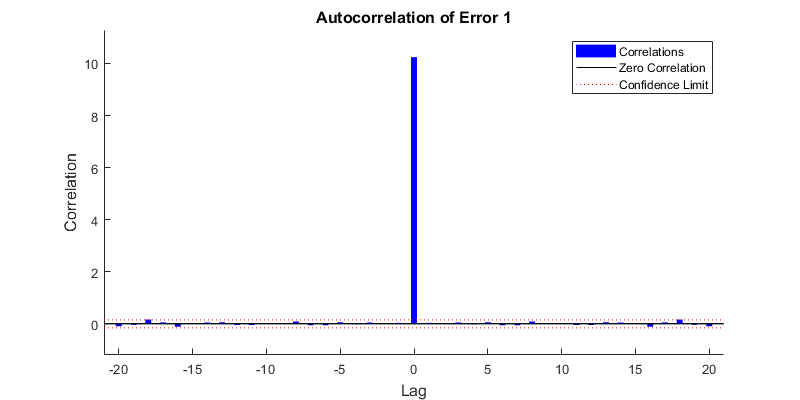 | Figure 4. Auto correlation error for the proposed model |
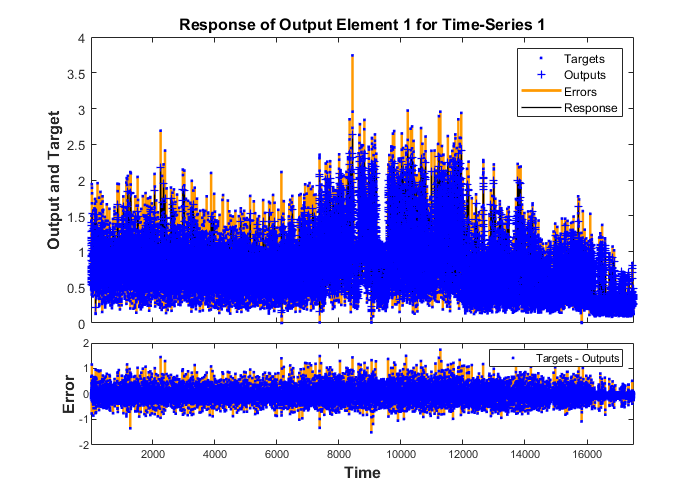 | Figure 5. Training response for the proposed model |
 | Figure 6. Error Histogram for fit set of the proposed model |
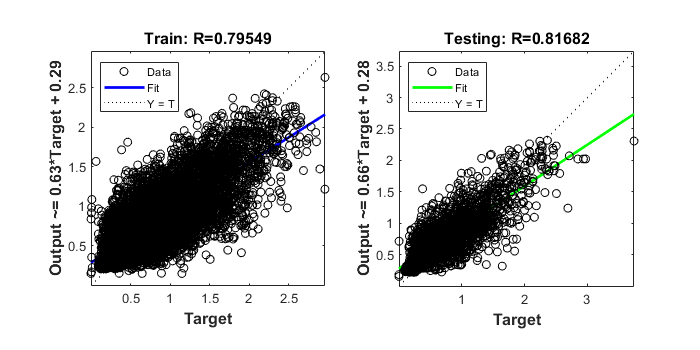 | Figure 7. Error regression on forecast vs. actual for the proposed model |
|
|
 | Figure 8. Comparison of performance metric use to ascertain the model accuracy |
5. Conclusions
- Recently a lot of attention and effort have move towards the design and implementation of smarter grids in building in order to balance the demand and supply of electricity effectively. A minimal improved of 1% in prediction accuracy will in turn save millions of pounds each year. To curtail the gap between demand and supply, new paradigms have to be employed that will use automated methods to dynamically forecast the buildings energy consumption. Many influencing factors make the prediction complex including: occupancy behaviors, weather conditions, parameter and model selection, missing data or incomplete information, and computation complexity of some models. Physics base or data driven base are the main method or approaches that is implored in the context of electricity prediction. Neural networks are recently applied for solving load forecasting due to their wide application. Deep neural network models provide a practical approach to energy consumption prediction. In this paper, we proposed NARX base deep recurrent neural network model to forecast electricity consumption in residential buildings. The predictions were made in sequences of 24-h at sub-hour resolution over a medium-term time horizon (>1 week). Overall, the proposed neural network models presented in this analysis perform better in forecasting electricity consumption for medium term time horizon. The following conclusions result from this analysis:• The proposed Deep recurrent neural network model, in general, performs better in terms of validation RMSE, MAPE and correlation error (R) than the existing model in the case of electricity consumption forecasting in residential buildings. The proposed model was able to account for long-term dependencies in the context of electricity consumption. in terms correlation error, the proposed model obtains a regression value close to 1 which clearly interpret that our model was perfectly fit for the data used in both the training, testing and validation phase respectively.• The proposed model uses external inputs (weather information) to forecast concurrently in other to curtail the uncertainty of weather condition which make the prediction more reliable and robust to future weather fluctuation.
6. Limitation
- The major limitation of the proposed model is that the model might probably yield inaccurate results when forecasting electricity consumption for dissimilar buildings or even for the identical buildings if major modifications have been made to its structure, equipment, occupancy or operations. Thus, the model couldn’t capture the influence of occupancy behavior and other future alterations to the prediction model. In our future work, this will be included.
ACKNOWLEDGEMENTS
- This study was supported by the Tertiary Education Trust Fund (TETFund) Institutional Based Research (IBR) Fund, through the directorate of Research and Innovation of Abubakar Tafawa Balewa University, Bauchi.
 Abstract
Abstract Reference
Reference Full-Text PDF
Full-Text PDF Full-text HTML
Full-text HTML
